Urban Pollinators
Cities and their surrounding areas are dominated by the built environment. Green space within cities surrounds us and provides pollinators with the pollen and nectar they need.
Download NowLearn all about the plants and pollinators below.
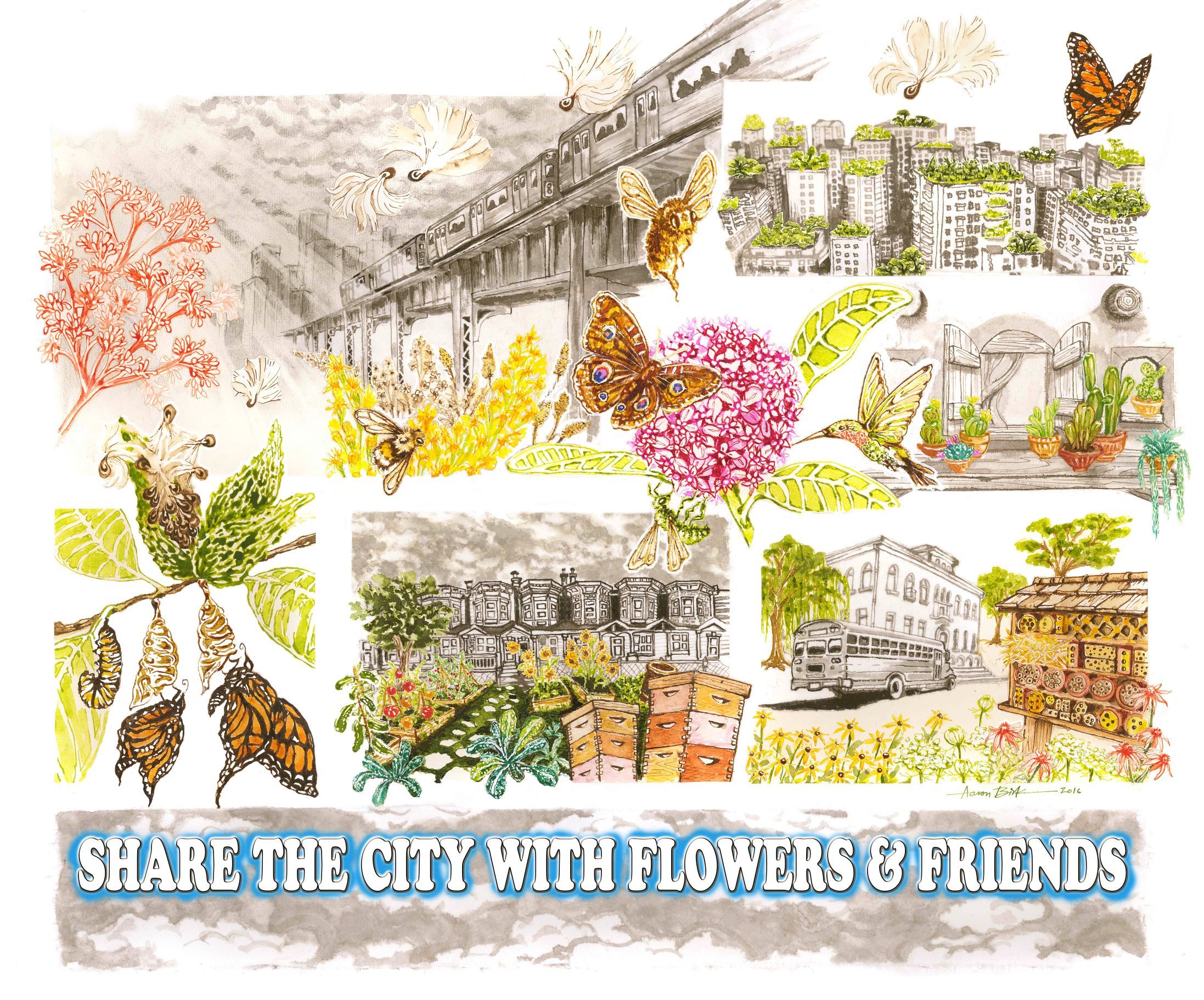
Urban Pollinators
Cities and their surrounding areas are dominated by the built environment. The thriving ecosystems that support local biodiversity and provide ecosystem services are often overlooked at first glance. Green space within cities surrounds us and provides pollinators with the pollen and nectar they need. City parks, home gardens, planted medians, manicured municipal spaces, rooftop gardens, and even weedy remnants are pollinator habitat within urban areas. “Share the City with Flowers and Friends”, designed and drawn by artist Aaron Birk, presents us with a collage of biodiverse cityscapes, each teaming with plants and pollinators.
Top Left (railway)
Dispersed patches of native flowers around the city may seem out of place among the concrete and steel infrastructure, but these spaces provide pollinators with an accessible source of pollen and nectar in areas that are dominated by urbanization. In this picture, a Western bumble bee (Bombus occidentalis) is enjoying a nectar treat on a patch of Western Goldenrod (Solidago lepida), among the Spotted Jo Pye weed (Eutrochium maculatum), and St. John’s Wart (Hypericum perforatum ) found within the city. Goldenrods, species in the genus Soledago, are very important to pollinators, as each plant contains hundreds of small, clustered flowers filled with valuable nectar that is easily retrievable by many pollinators. Goldenrods also depend on pollinators to disperse pollen from one plant to another for fertilization. While these scruffy patches of urban vegetation may not look like much, and at times appear weedy and unwarranted, they are home to many pollinators and other urban wildlife.
Train at Lelant Saltings, by Gloworm 44
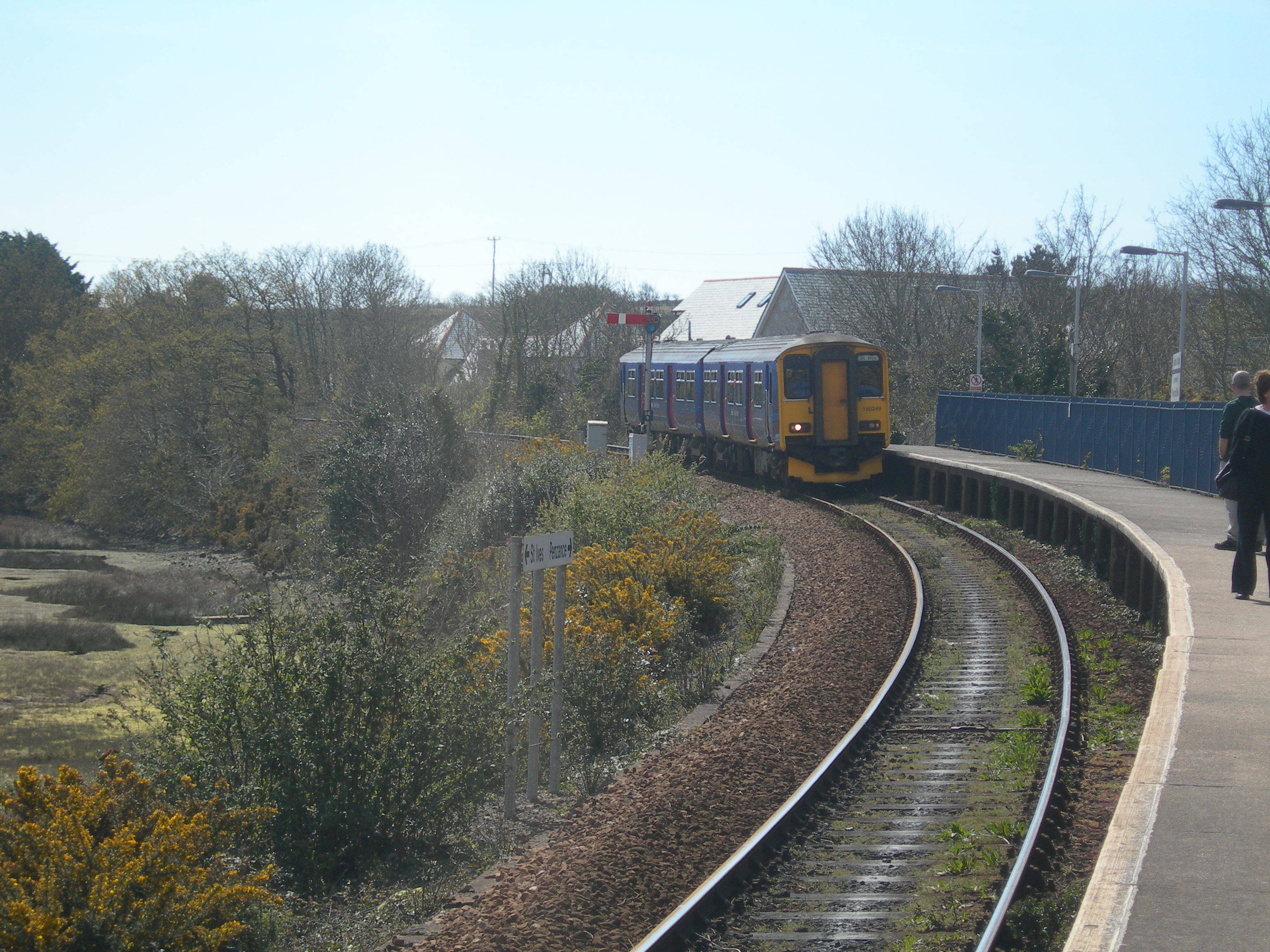
Plants:
- Spotted Joe Pye weed, Eutrochium maculatum
- Western Goldenrod, Solidago lepida
- St. John’s Wart, Hypericum perforatum
Pollinators:
- Western Bumble bee - Bombus occidentalis
Center (Milkweed flower being visited by pollinators)
Common milkweed (Asclepias syriaca) is a pollinator essential that can be seen all over urban areas whether in public parks, personal gardens, or in city planned green spaces. In this picture, multiple pollinators can be seen enjoying their sweet nectar meal including a large Mason bee (Osmia cornifrons)(top), an brilliant sweet bee (Agapostemon texanus) (bottom), a common buckeye (Junonia coenia) (left), and a ruby throated hummingbird (Archilochus colubris )(right). Blooming milkweed contains a spherical ball of small purple flowers, each filled with nectar that is easily accessible to many types of pollinators ranging from insects to birds, due to the shallow shape of each individual flower structure. Native bees such as mason bees and sweet bees rely on native plants such as common milkweed as an essential source of food, making even the smallest patch of milkweed important for foraging pollinators within a city environment. Common milkweed is considered a ‘magnet species’ that supports a broad range of pollinators.
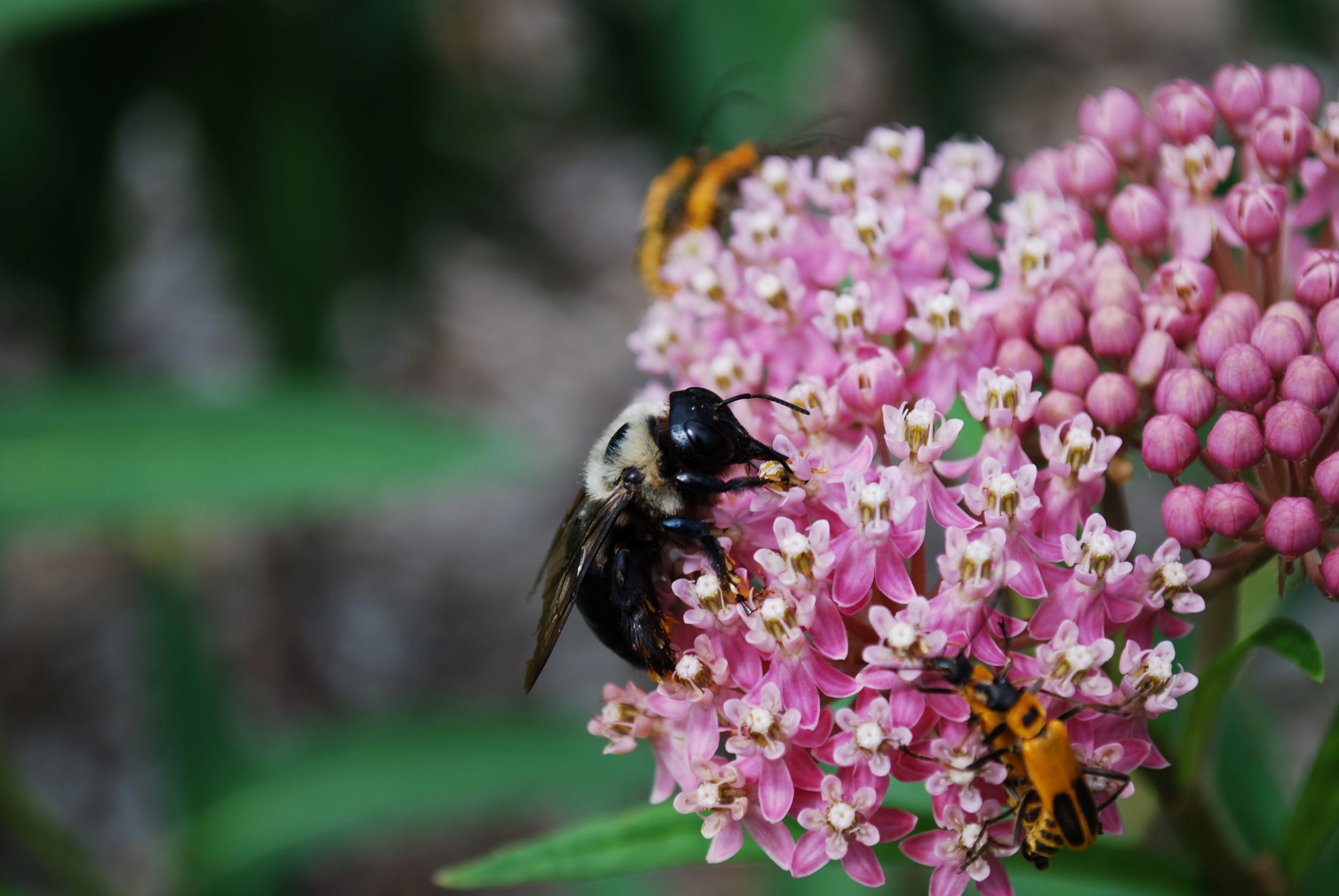
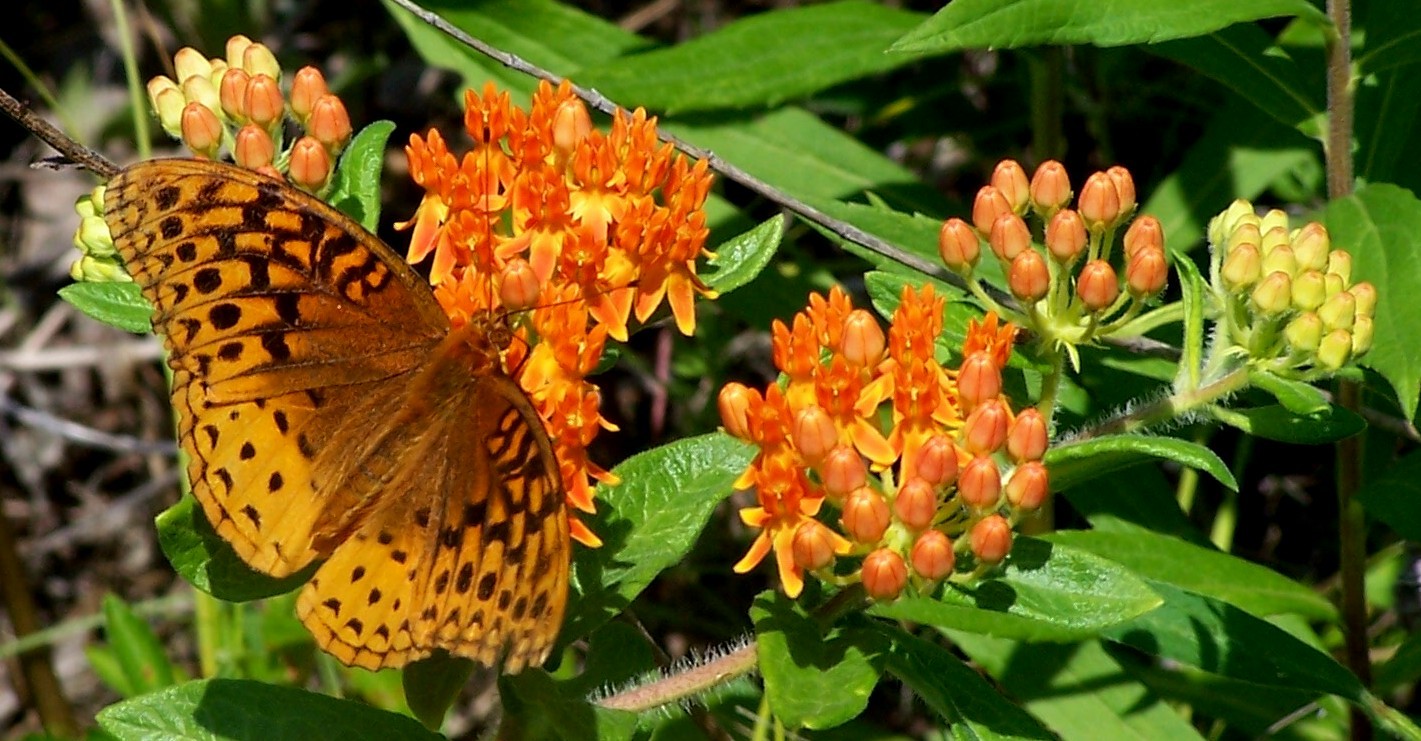
Plants:
- Common Milkweed, Asclepias syriaca
Pollinators:
- Green Sweat Bee, Agapostemon texanus
- Horn-Faced Bee, Osmia cornifrons
- Ruby Throated Hummingbird, Archilochus colubris
- Common Buckeye, Junonia coenia
Lower Left (Monarch Butterfly emerging from chrysalis, milkweed pod going to seed)
If you plant it, they will come! This phrase is perfect when thinking about monarch butterflies and milkweed. Monarchs are dependent on milkweed plants throughout their entire lifecycle. Adult monarchs rely on milkweed flowers for nectar, and the leaves of the milkweed plants are needed to feed their growing and developing caterpillars. Monarch caterpillars are obligate milkweed eaters, they cannot survive on other plants; female monarch butterflies look exclusively for milkweed when seeking sites to lay their eggs. Once caterpillars emerge from these eggs, they feed on the leaves of the milkweed plant which provides them with sustenance and energy to mature, but also interestingly helps protect them by increasing the presence of the toxic chemical cardenolide aglycones in their body. Once the caterpillars reach a certain stage (the 5th instar of their development), they will form a chrysalis, soon to become the beautiful and large butterflies we see fluttering around on warm summer days. Monarch dependence on the milkweed plant can be seen in this picture, starting on the left side with the feeding caterpillar, then towards the middle with the structured chrysalis, and then on the right side of the picture with the fully mature monarch butterfly drinking the nectar produced by the milkweed flowers.
Monarch Emerging from Chrysalis, by Megan McCarty
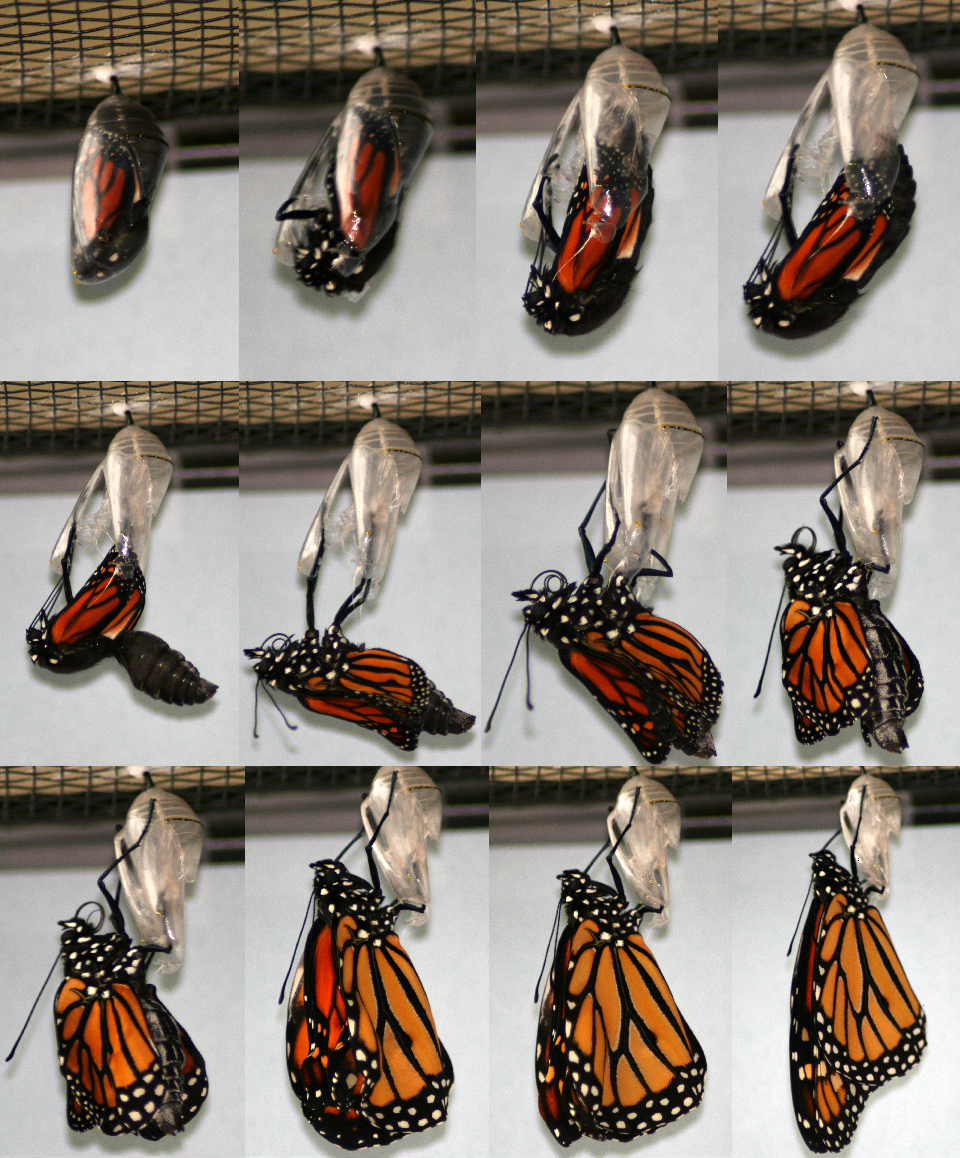
Milkweed Seeds, by Sarah Nystrom, USFWS
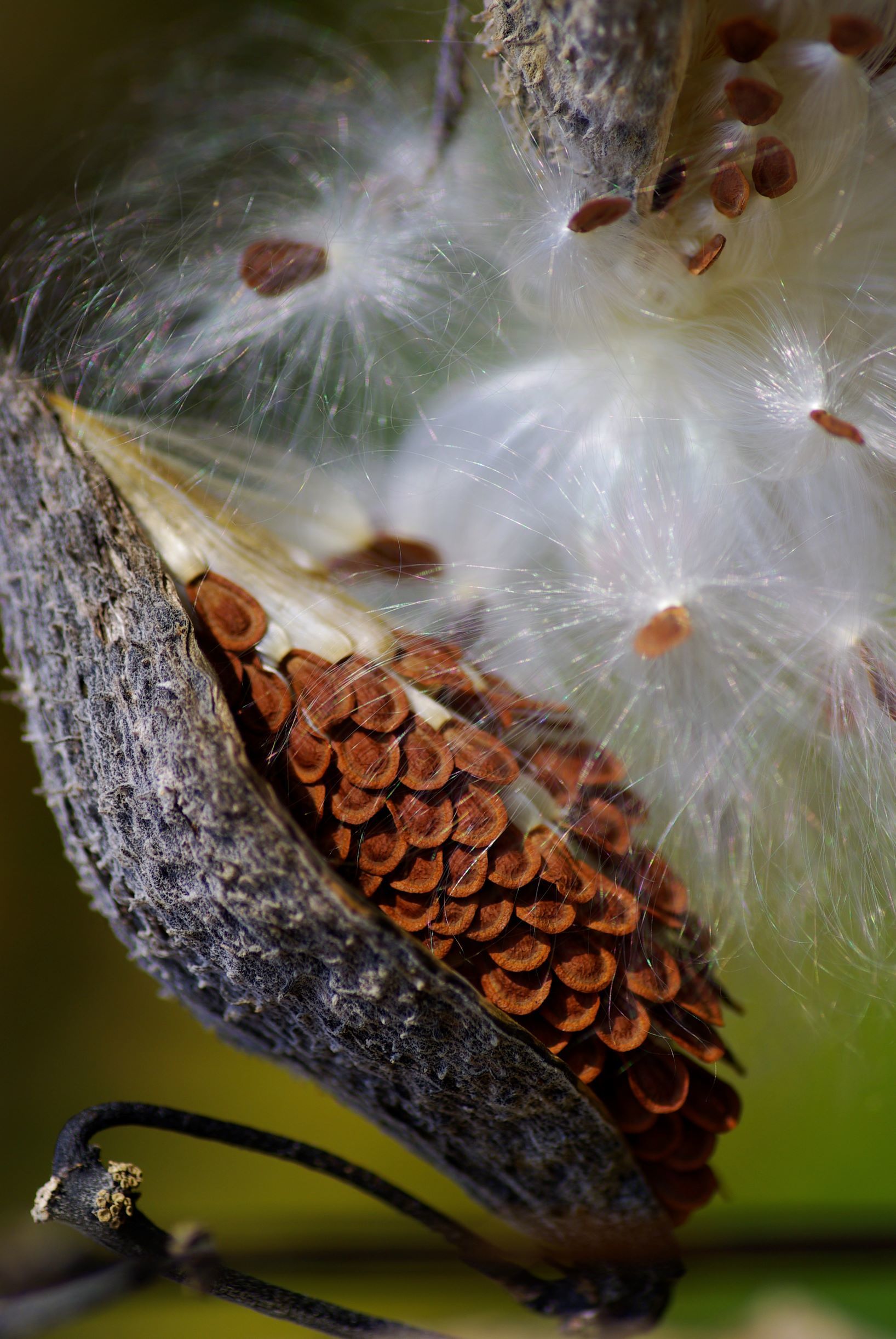
Plants:
- Common Milkweed, Asclepias syriaca
Pollinators:
- Monarch Butterfly, Danaus plexippus
Top right (Rooftop gardens, monarch flying by)
This picture depicts a monarch butterfly flying towards rooftop greenspaces. Rooftop gardens are a growing trend in urban areas where backyard gardens are sometimes not possible. Green roofs are also becoming more popular as city planners, designers, and landscapers look to increase green space and ecological function in cities. A key factor in making rooftops into habitat for pollinators is having the correct plants. There are many great pollinator plants that have shallow roots and do well on rooftops or planters that are available in every region. By planting these species on rooftops, individuals living in the city can help provide high flying pollinators, such as monarchs, with sustainable food sources. Monarch butterflies are especially known for their high flying ability, being able to fly up to 11,000 ft! Bees are also known to use rooftop habitats, but they tend to favor heights below nine stories.
Chicago City Hall Green Roof, by Conservation Design Forum
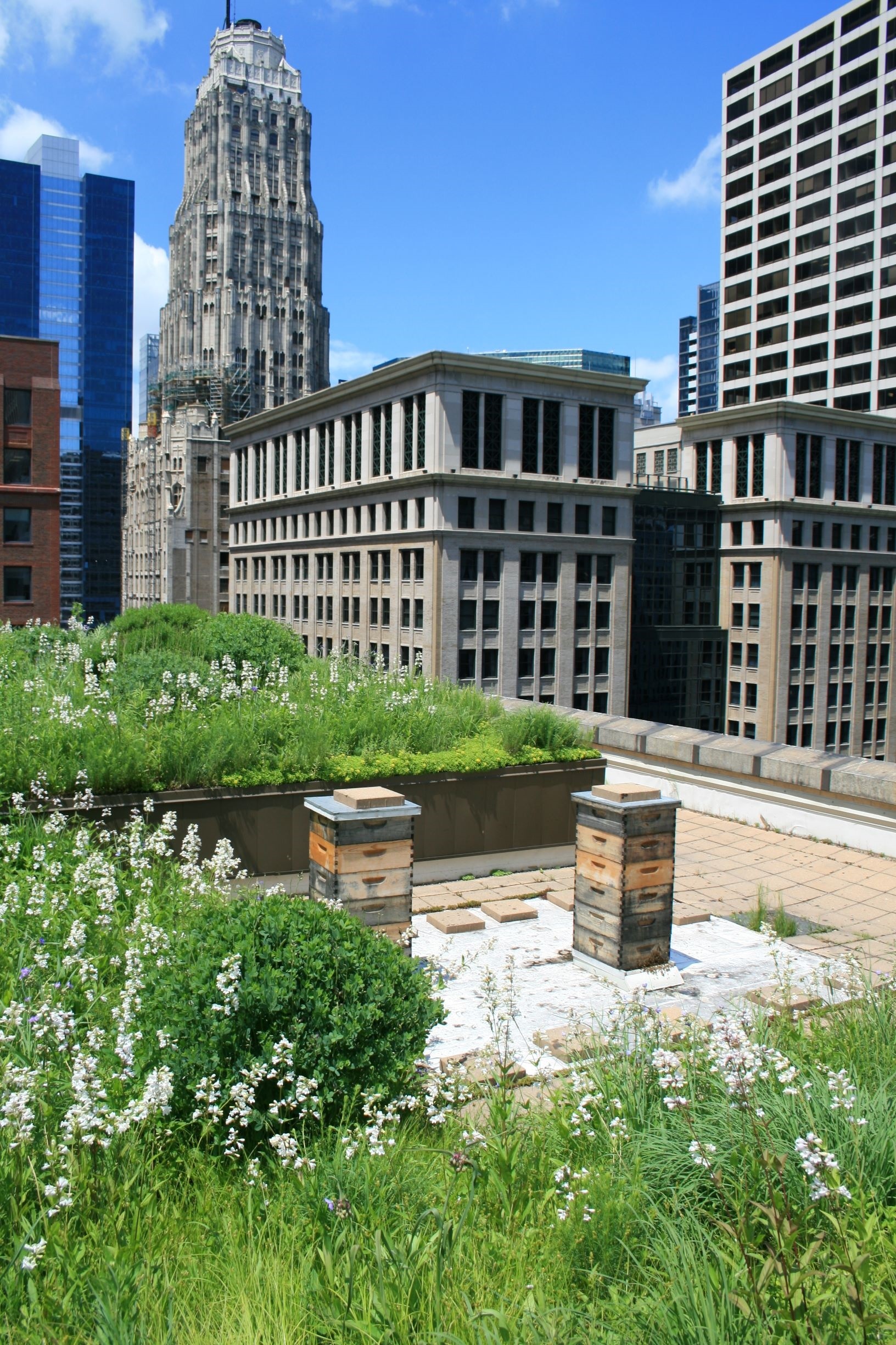
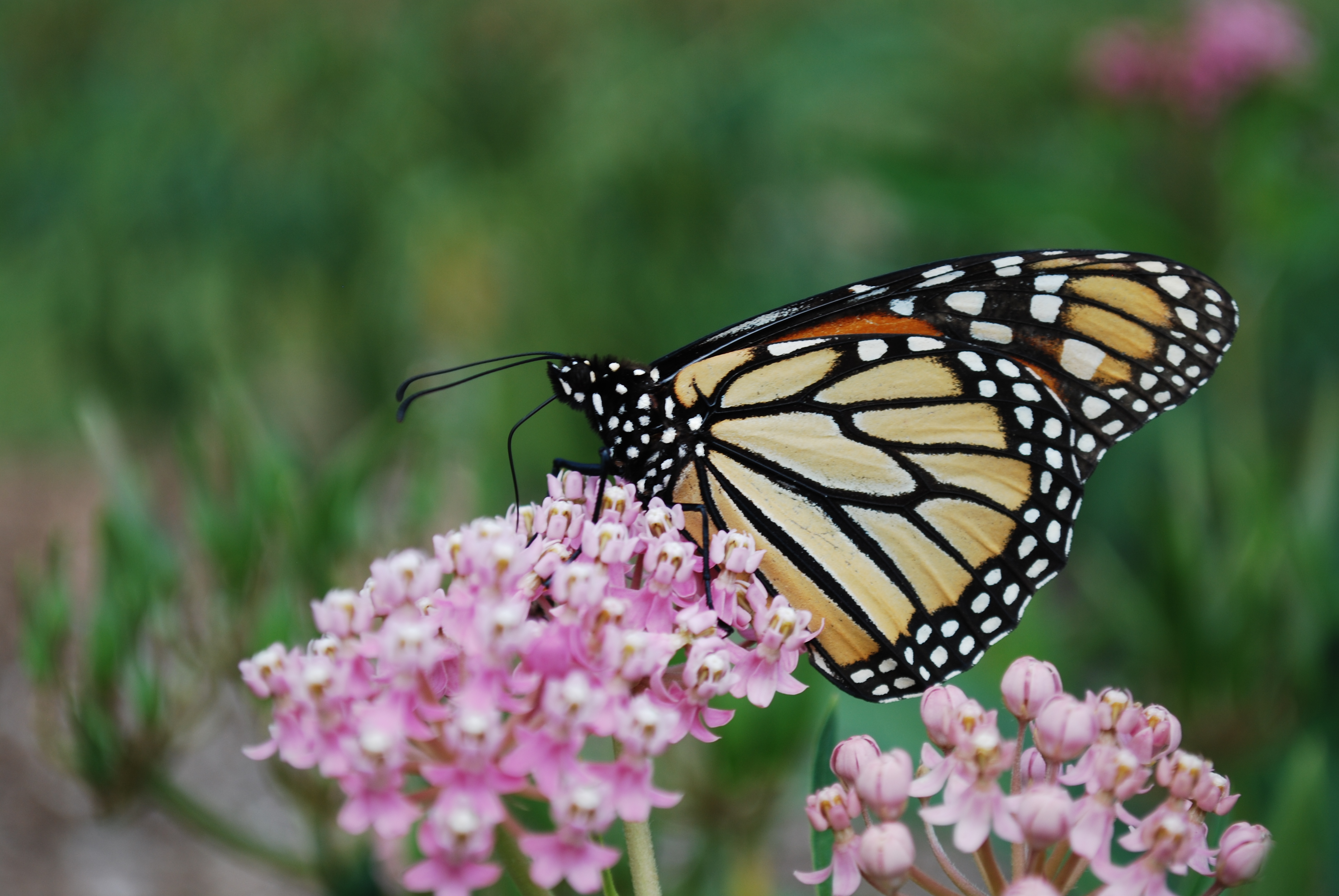
Pollinators:
- Monarch Butterfly, Danaus plexippus
Middle right (Southwestern Window box with Succulents)
Window box gardening is a great and easy way to provide pollinators with an available food source in urban areas that lack natural green spaces. Window box gardening can be done in any region, and the plants used can be selected according to climate and geographic location. This picture depicts a window box garden filled with succulent plants most likely located in the southwestern United States. The succulent plants depicted are Nopalea karwinskiana, which are pollinated by hummingbirds, Hylocereus undatus, and Echinocactus grusonii which are pollinated by solitary bees. Even though these succulents may not seem to be the obvious planting choice when wanting to provide pollinators with a food source, many succulents do in fact flower and produce nectar that can be used by many different pollinator species
Window Box, by Mark Sadowski
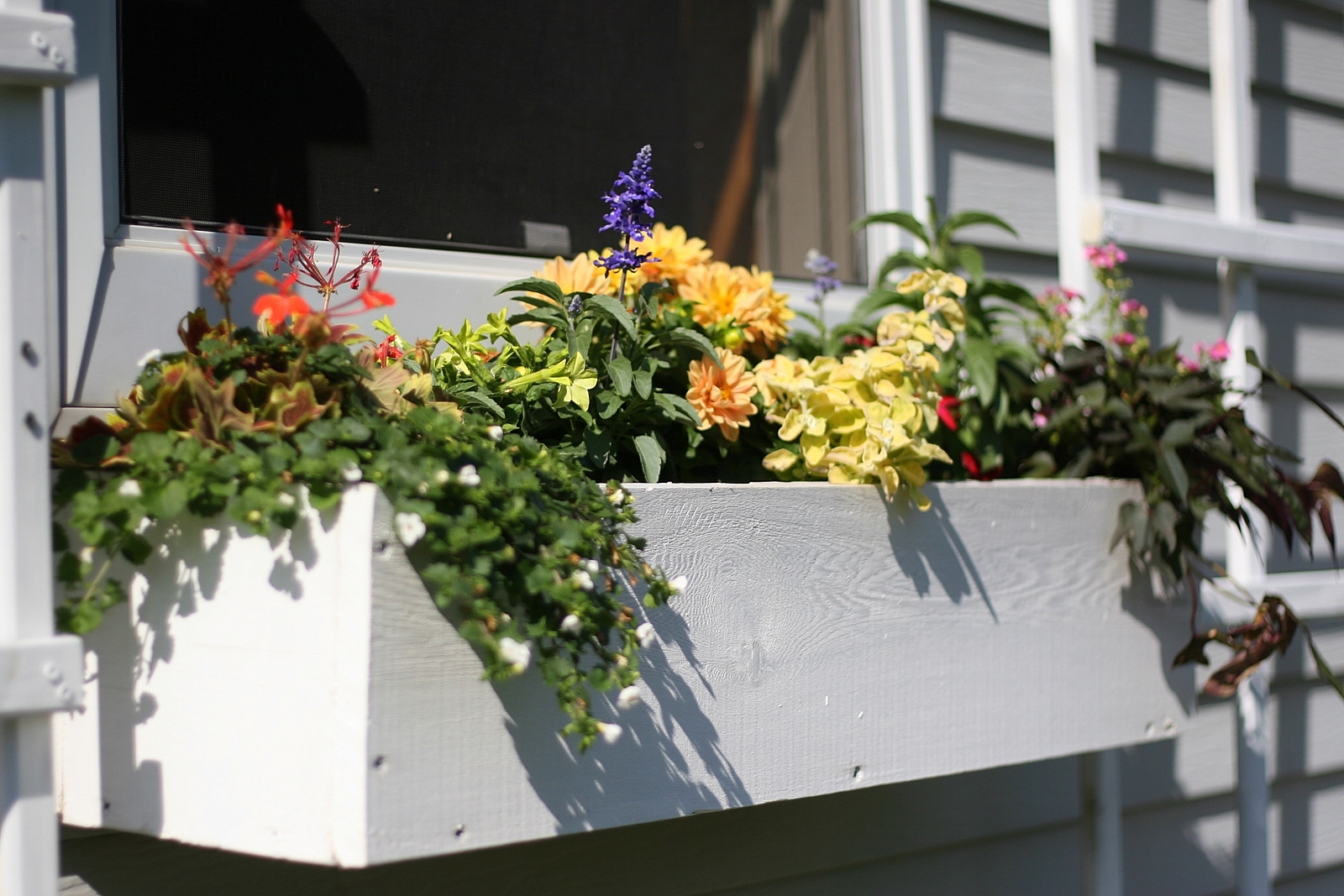
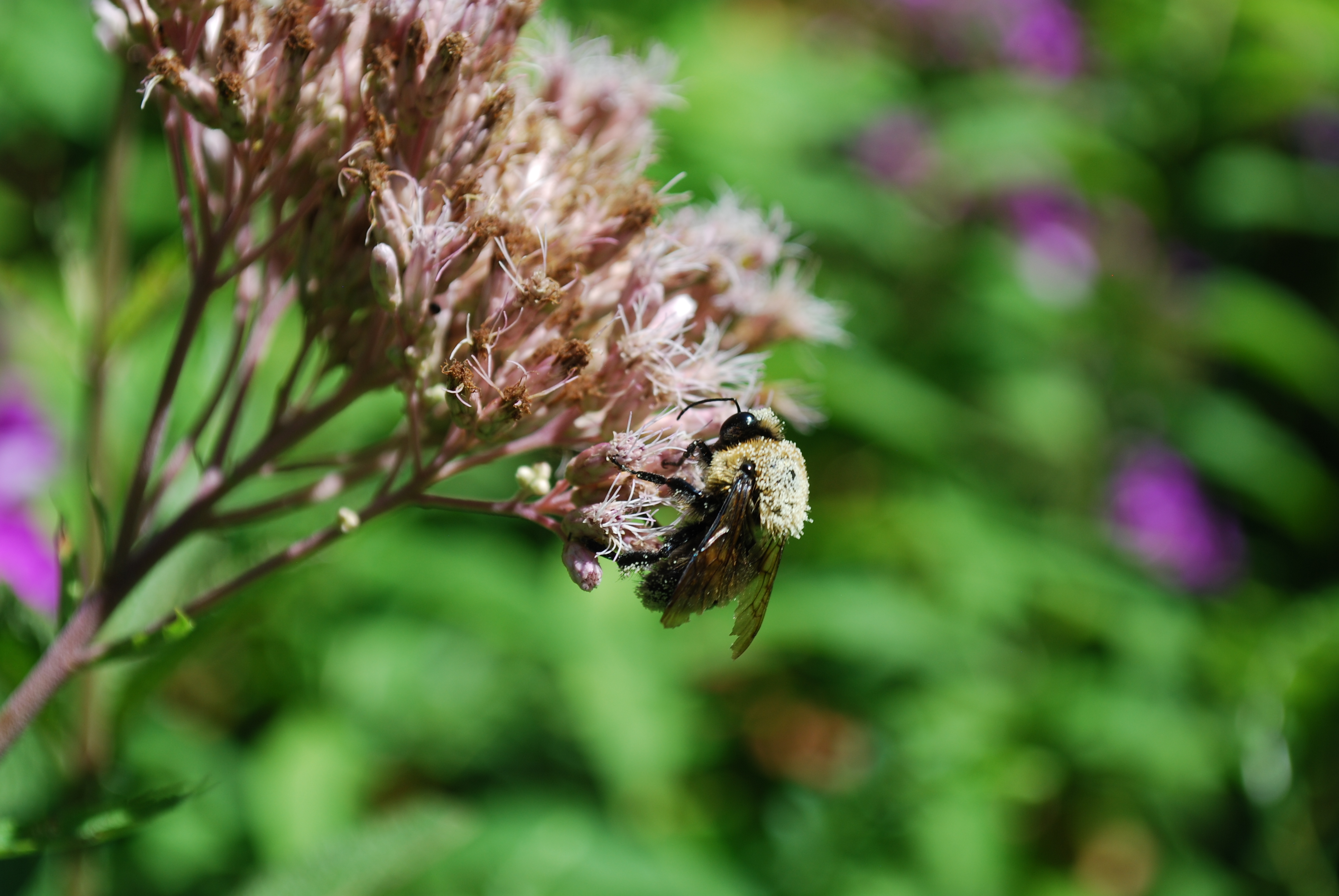
Plants:
- Yaga Biaa Gueta, Nopales karwinskiana
- Pitahaya, Hylocereus undatus
- Golden Barrel Cactus, Echinocactus grusonii
Bottom Right (school garden and bee hotel)
A quick field trip to the school garden to watch bees and butterflies enjoy their nectar meals can inspire younger generations to learn about their local ecology and help encourage conservation practices to protect our pollinators. The design, planting, and maintenance of a school pollinator garden enhances curriculum and offers opportunities for outdoor education. Through the planting of local plant species in school gardens, or through the construction and maintenance of bee hotels, kids are able to observe plant-pollinator interactions and can understand the importance in providing pollinators with accessible and sustainable food sources. Maintenance is very important for bee hotels, as they must be kept clean and free of pests and mold to ensure the survival of resident bees. This school garden includes Black-eyed Susan, Rudbeckia hirta, Pale Purple Cone Flower, Echinacea pallida, and Yarrow, Achillea millefolium, common species that attract a diversity of pollinators. School gardens not only provide local pollinators with a reliable food source, but can also be educational to the children and younger generations attending school.
Height High School Garden
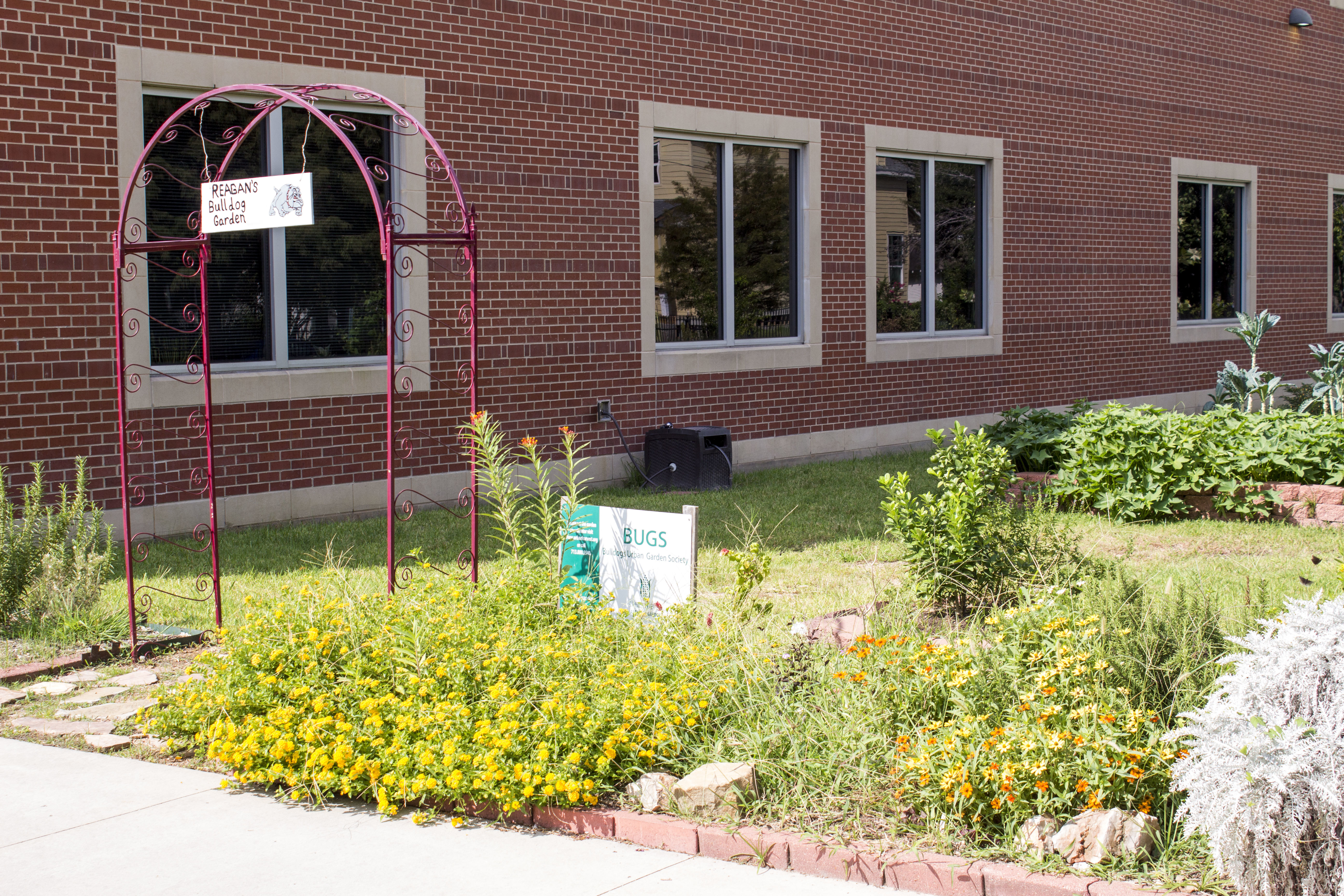
Somers middle School Planting Native Garden, By US FS Northern Region
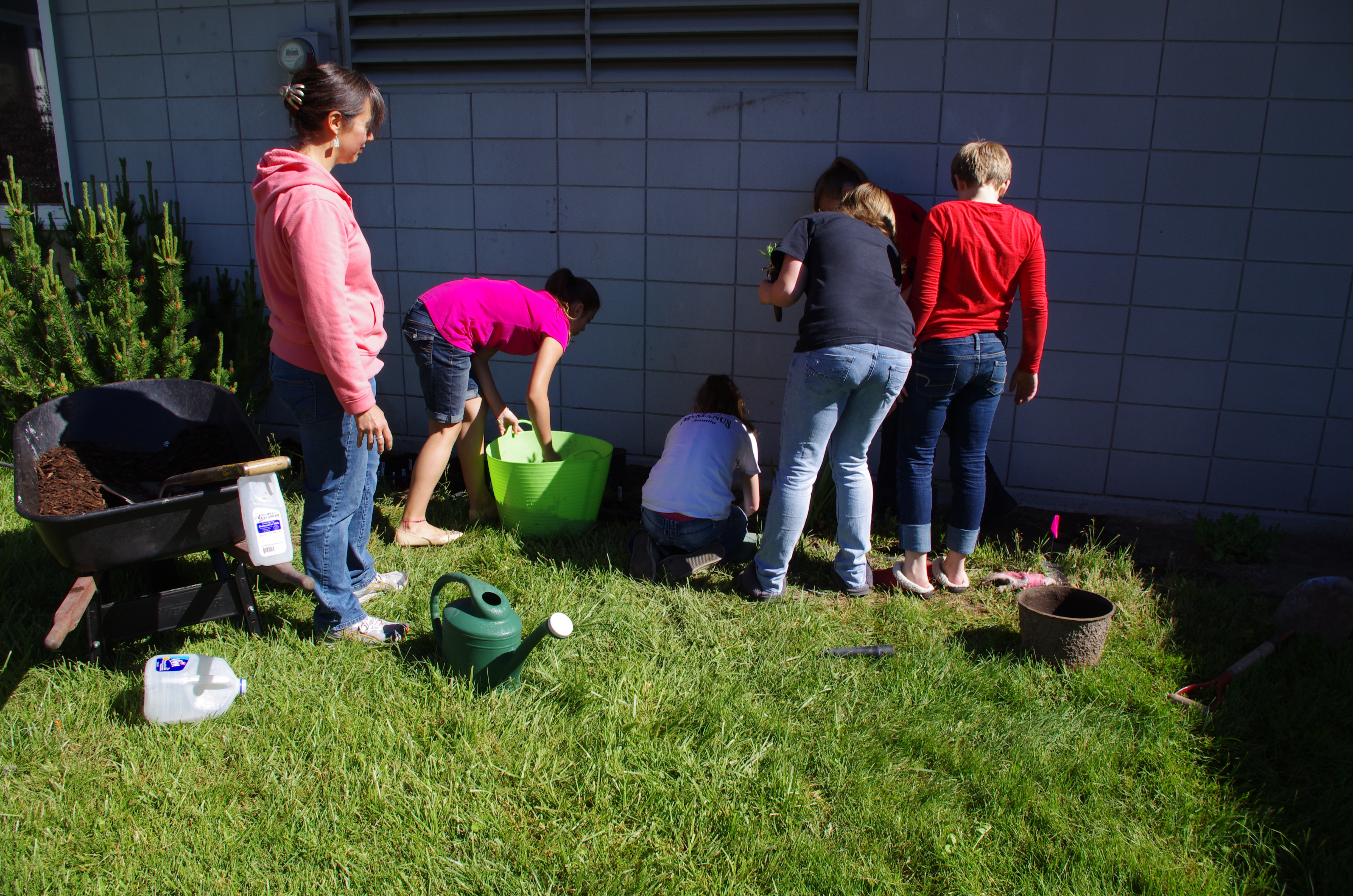
Plants:
- Black-eyed Susan, Rudbeckia hirta
- Pale Purple Cone Flower, Echinacea pallida
- Yarrow, Achillea millefolium
Center Bottom (community garden)
Although urbanization fragments provide possible feeding areas for pollinators, there are many ways that a community as a whole can help provide habitat for pollinators. Community gardening is one such example, as bees, flies, and butterflies that are foraging for pollen and nectar within the city use fruit and vegetable flowers. This can be seen in the poster, where Kale, tomatoes, and sunflowers have been planted for human consumption, but secondarily provide pollinators with flowers and available nectar to consume. A city environment might not appear to be the best location for a beehive, but over the past few years urban beekeeping has grown in popularity with many beekeepers maintaining populations in urban areas. Honeybees can forage over large distances, commonly up to two miles or more. They are able to find sources of pollen and nectar located throughout cities and suburbs.
High Point Community Garden, Seattle, by Paul Symington
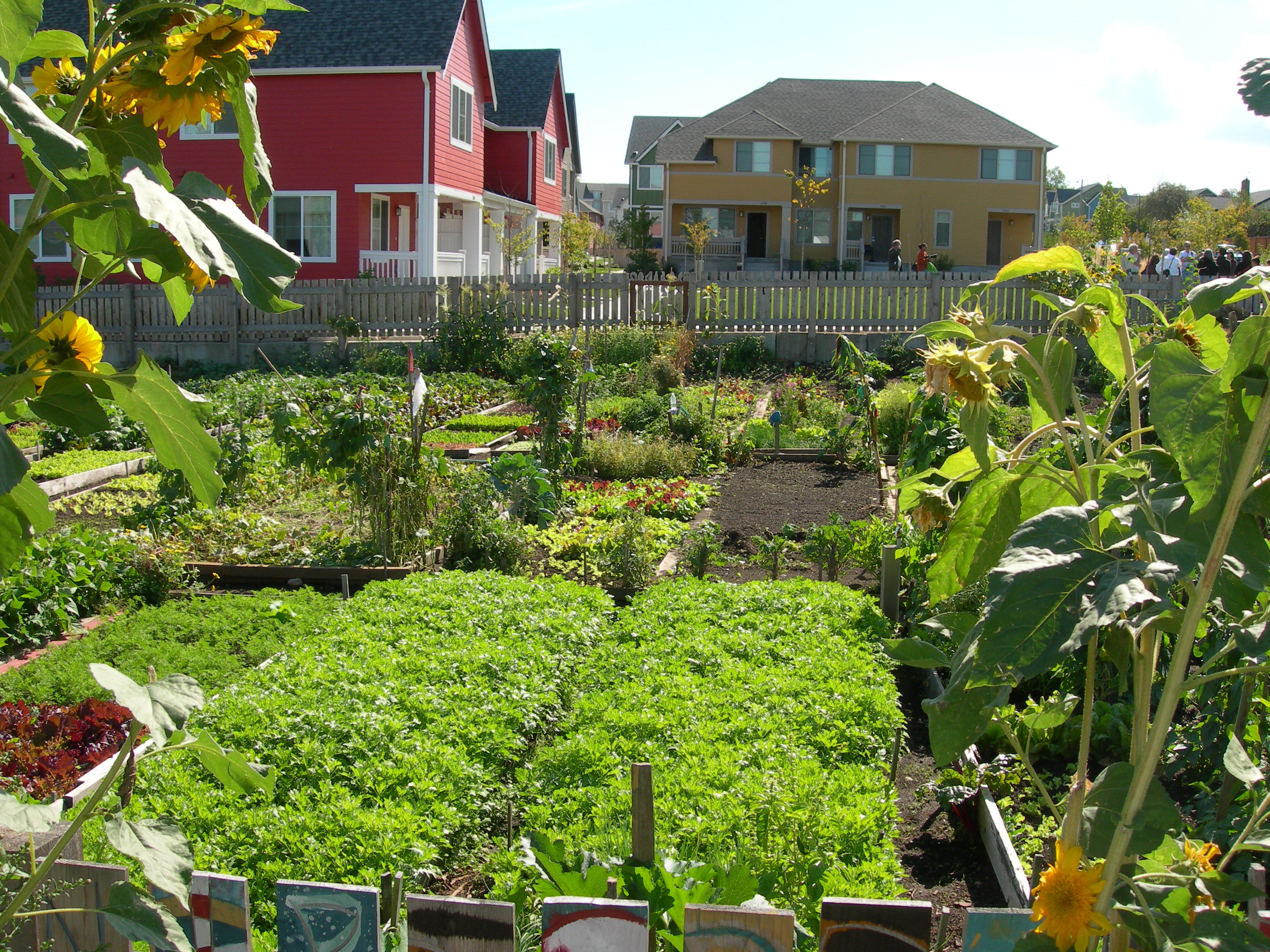
Community Gardening Event in East Vancouver, Canada, by Hu Gadam
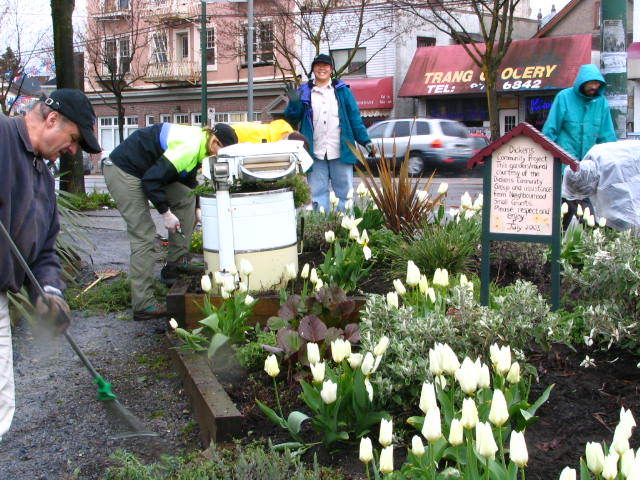
Plants:
- Kale, Brassica oleracea var. sabellica
- Tomato, Solanum lycopersicum
- Sunflower, Helianthus annuus
Urban Habitat
Bee Hotels
Smithsonian Bee Hotel
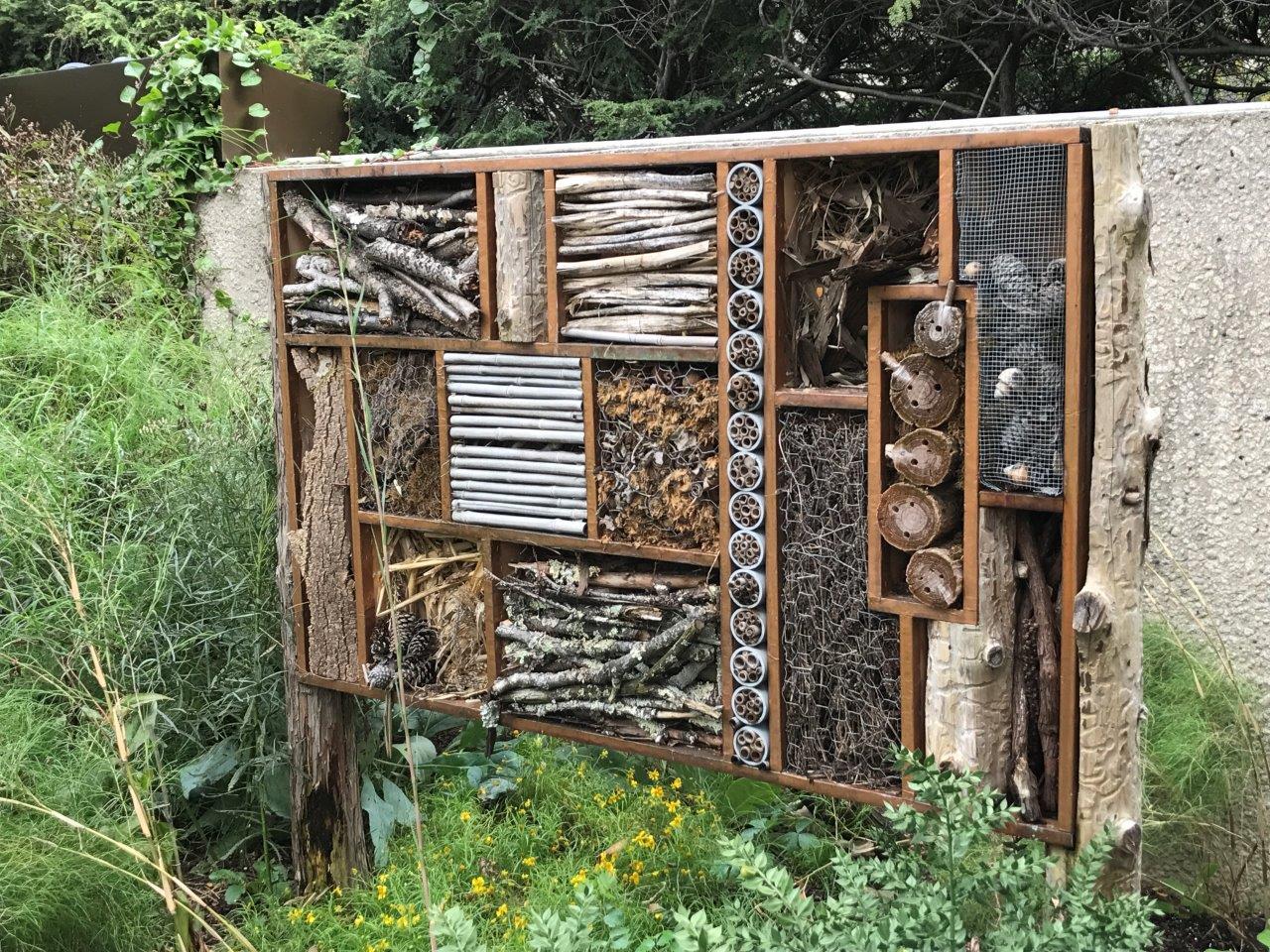
Fairmont Toronto Bee Hotel
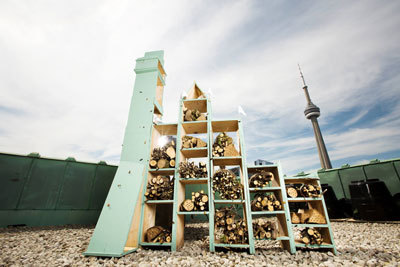
Not all bees live together in hives. Some species are solitary bees, and bee hotels provide solitary bees like mason bees and leafcutter bees with potential living spaces. Solitary bees have a short lifespan and do not travel far before finding a new home. Males have two weeks in which they are actively flying, whereas females fly for around 4 - 6 weeks. The females not only have to build their own nests, but also have to gather all the necessary pollen and nectar. They will often lay their eggs within the hole and then cover the opening with a mud layer. The stored pollen will be consumed by the larva until it is ready to break off from the mud and fly away. These bee hotels not only provide nearby solitary bees with a potential home, but they also increase pollinator activity in the surrounding area. These hotels can be built out of a variety of materials such as cardboard tubes, wood, and plastic. Often times the solitary bees that live in bee hotels are less aggressive than other bees. They will avoid stinging unless it is their only option.
Green Rooftops
California Academy of Science Rooftop Garden, by Perry Planet
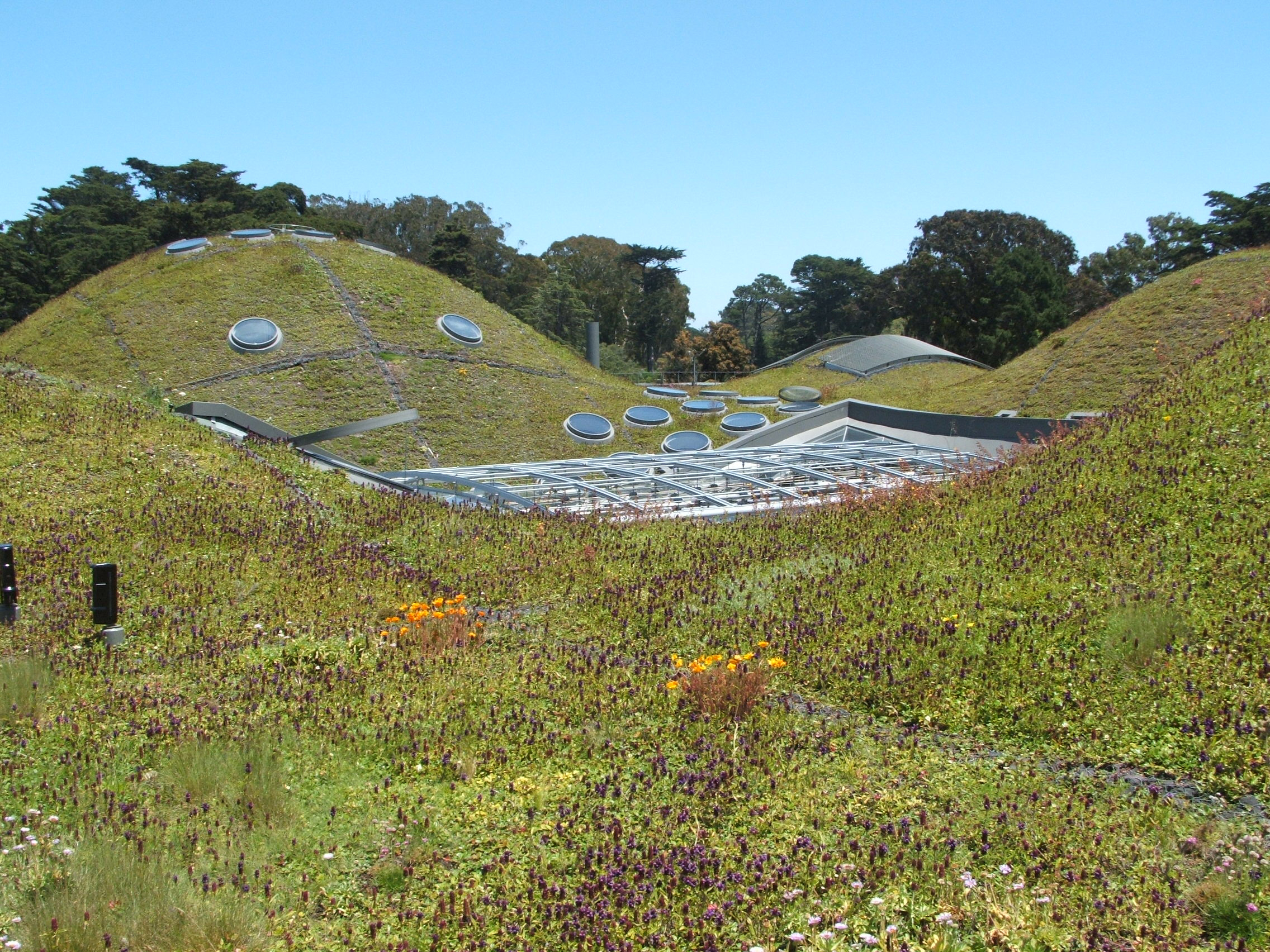
Daniel F. and Ada L. Rice Plant Conservation Science Center Green Roof Garden
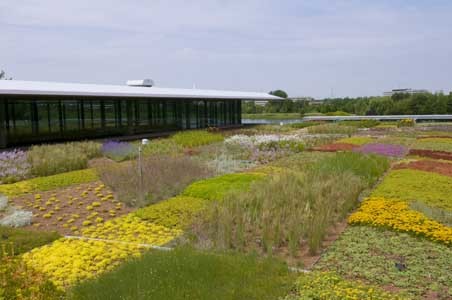
Much like the rooftop gardens, green roofs can benefit a city in many ways too. They can help reduce the heat island effect and have also been shown to reduce energy use. By shielding the building from direct sunlight they are able to provide better insulation. This added insulation will reduce the amount of energy required to either heat or cool the building. Green roofs provide many of the same benefits as rooftop gardens. In addition they provide better storm water management, an improved aesthetic, and a great potential to enhance pollinator habitats! Green roofs differ from roof top gardens in that they have vegetation directly planted on the roof with a protective membrane underneath, whereas a rooftop garden in created with containers placed on the roof. In some cases a green roof can be used for gardening!
Backyard Beekeeping
Beekeeping on USDA Headquarters Roof, by Lance Cheung - USDA
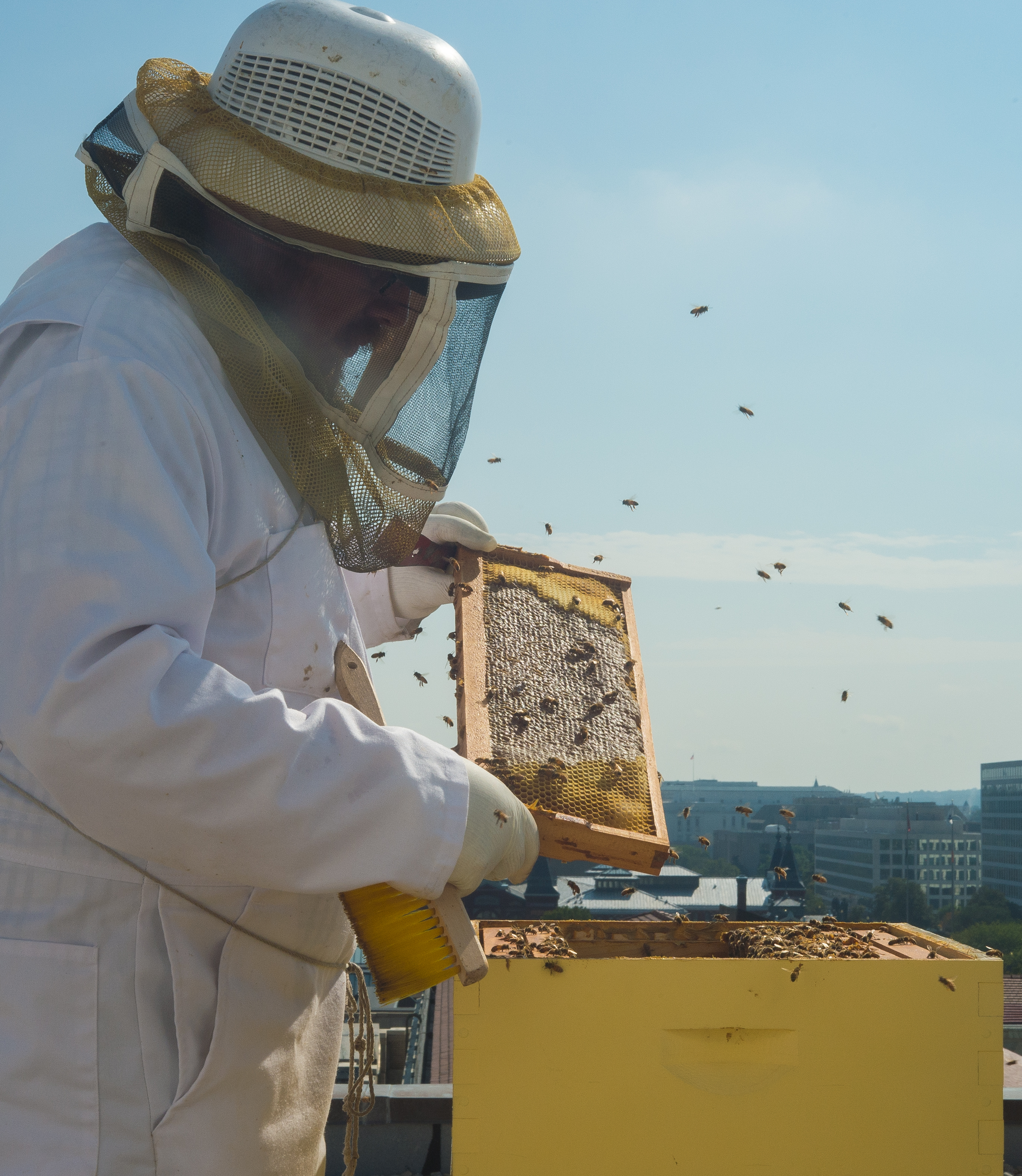
Beekeeping in Alberta, Canada, by Migco
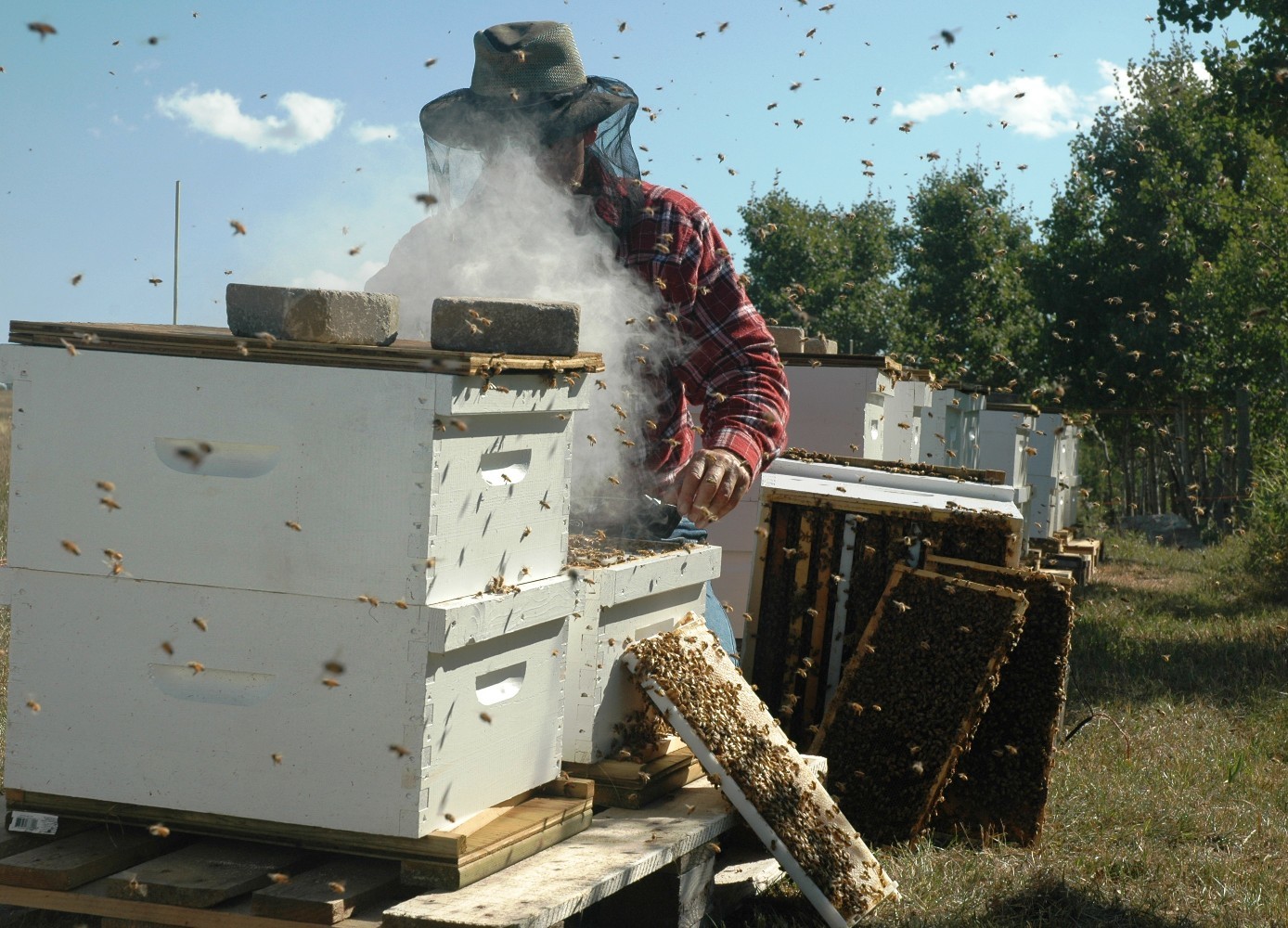
Beekeeping can be done in backyards and on rooftops. Wooden beehives provide great homes for honeybees. These honeybees are able to pollinate nearby plants and provide honey for human consumption. Having backyard hives allows an individual or a family to engage in understanding the importance of bees. Observing their routines and patterns allows us to see how bees work together as a unit to build and care for their hives, and this brings their world closer to ours. Having a backyard beehive can provide honey and other products such as beeswax. Some businesses have started to add hives to their rooftops and they use the honey in some of their own products. One should check with their local government to see if there are special permits or registrations required for your area. If you are unable to have a backyard or rooftop beehive a community apiary is a great alternative.
Community Apiaries
Beekeeping, by Stephen Ausmus - USDA ARS
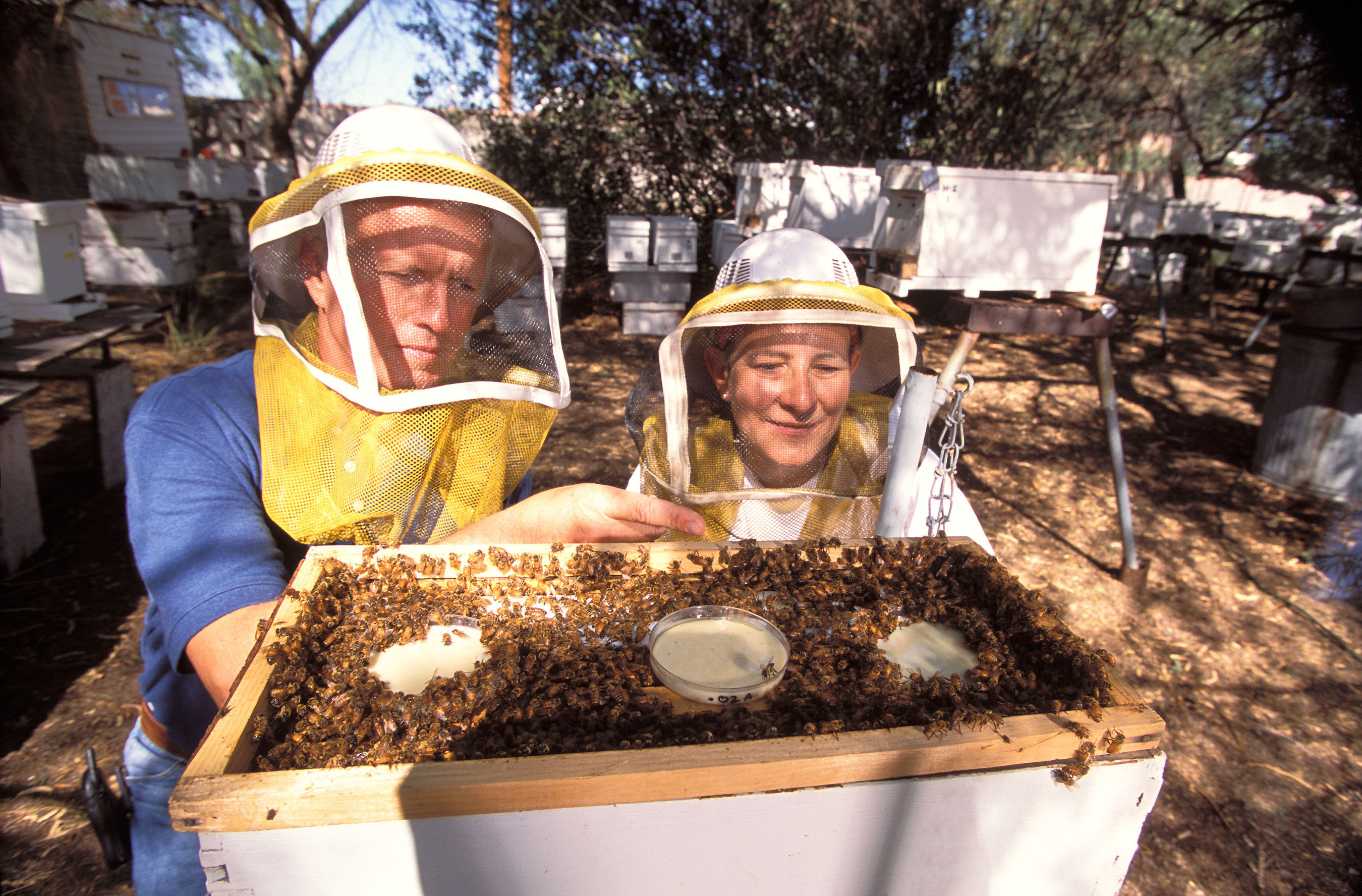
Community apiaries allow for beekeepers to maintain hives in a community space. Often there is a small fee to rent the space, but the beekeepers own all of the equipment and manage the hives together. This allows them to harvest and keep the honey! Not all apiaries require a small fee, but instead may require participation in outreach programs or to help with maintaining the area and/or a pollinator garden. This community space can be great for people to gain support from likeminded beekeepers, and allows first time beekeepers to learn from their community. This is a great alternative if you are unable to keep a beehive in your backyard or rooftop due to restrictions.
Wildlife/Pollinator Corridors
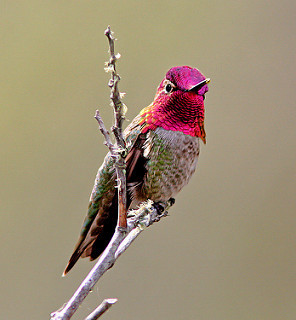
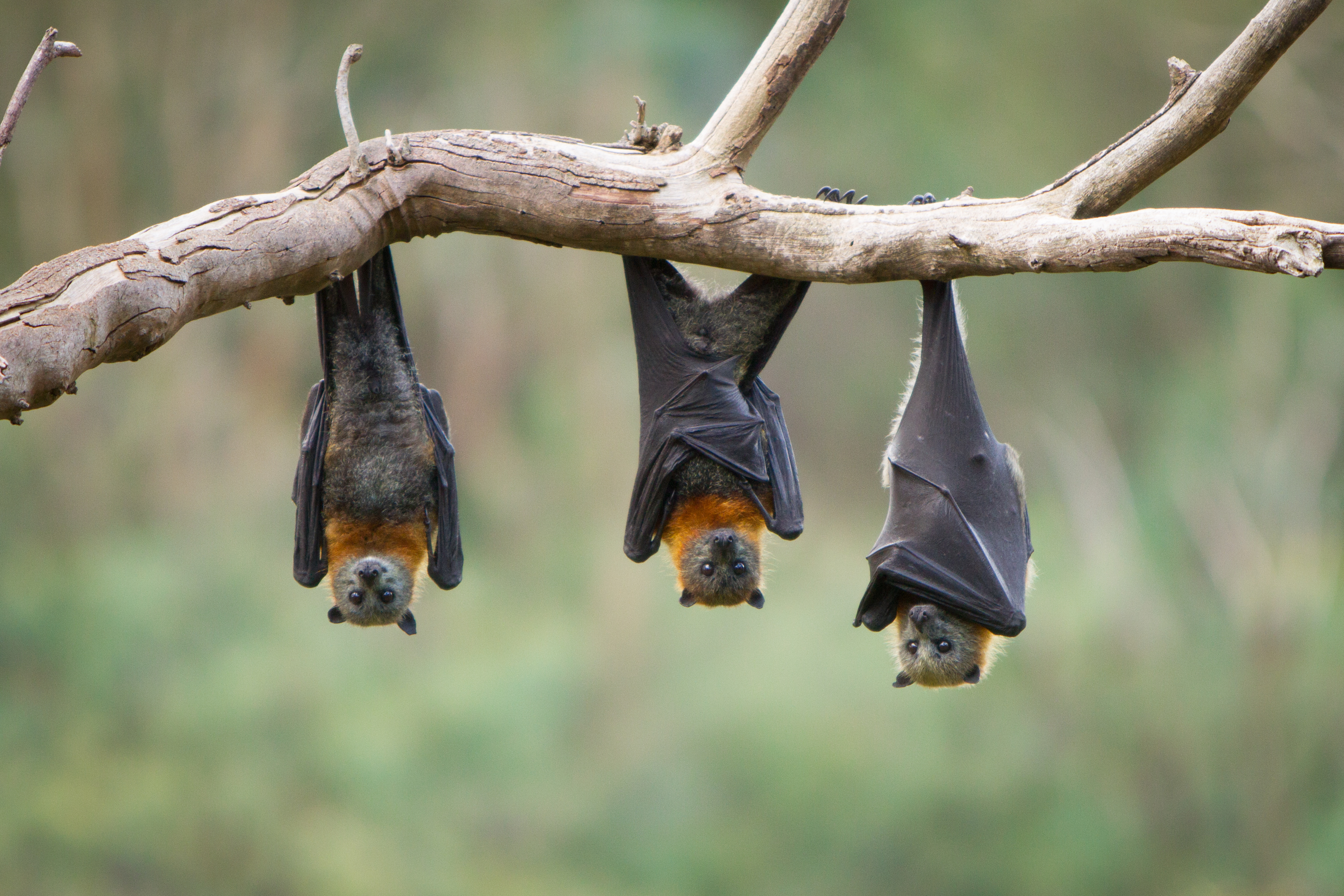
Wildlife/Pollinator corridors are thought of as stepping stones between two larger areas of viable habitat. This allows for animals to have smaller areas of land that they can use to forage or protect themselves while moving between areas. For pollinators this is especially important in an urban setting. By providing small green spaces, one is able to help bridge gaps between disturbed environments that might prove to be hostile to pollinators. Cities have begun developing and expanding these corridors. This can include rooftop gardens or curbside areas alike. It engages the community by getting the public involved in creating green spaces in their cities, and also brings awareness to the environment. The space does not need to be the size of a park, even a small area provides immense benefits for a corridor. Small pollinator gardens such as rooftop gardens, window sill plants, and green spaces along fences provide pollinators with foraging opportunities. This also bridges the gap between possible nesting sites throughout a city.
Community Gardens
Ft. Mason, San Francisco Community Garden, by Orin Zebest
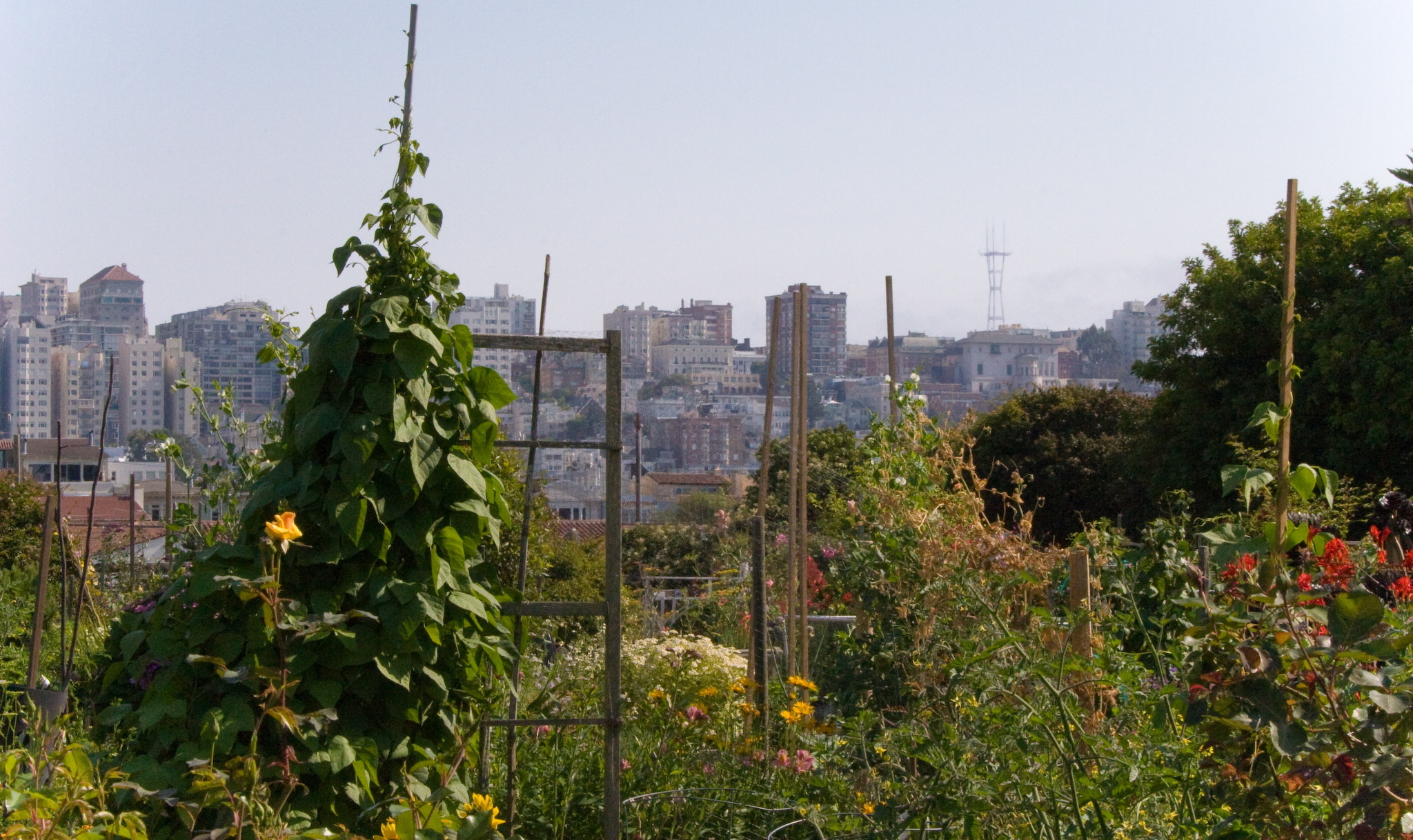
Danny Woo Community Garden, by Joe Mabel
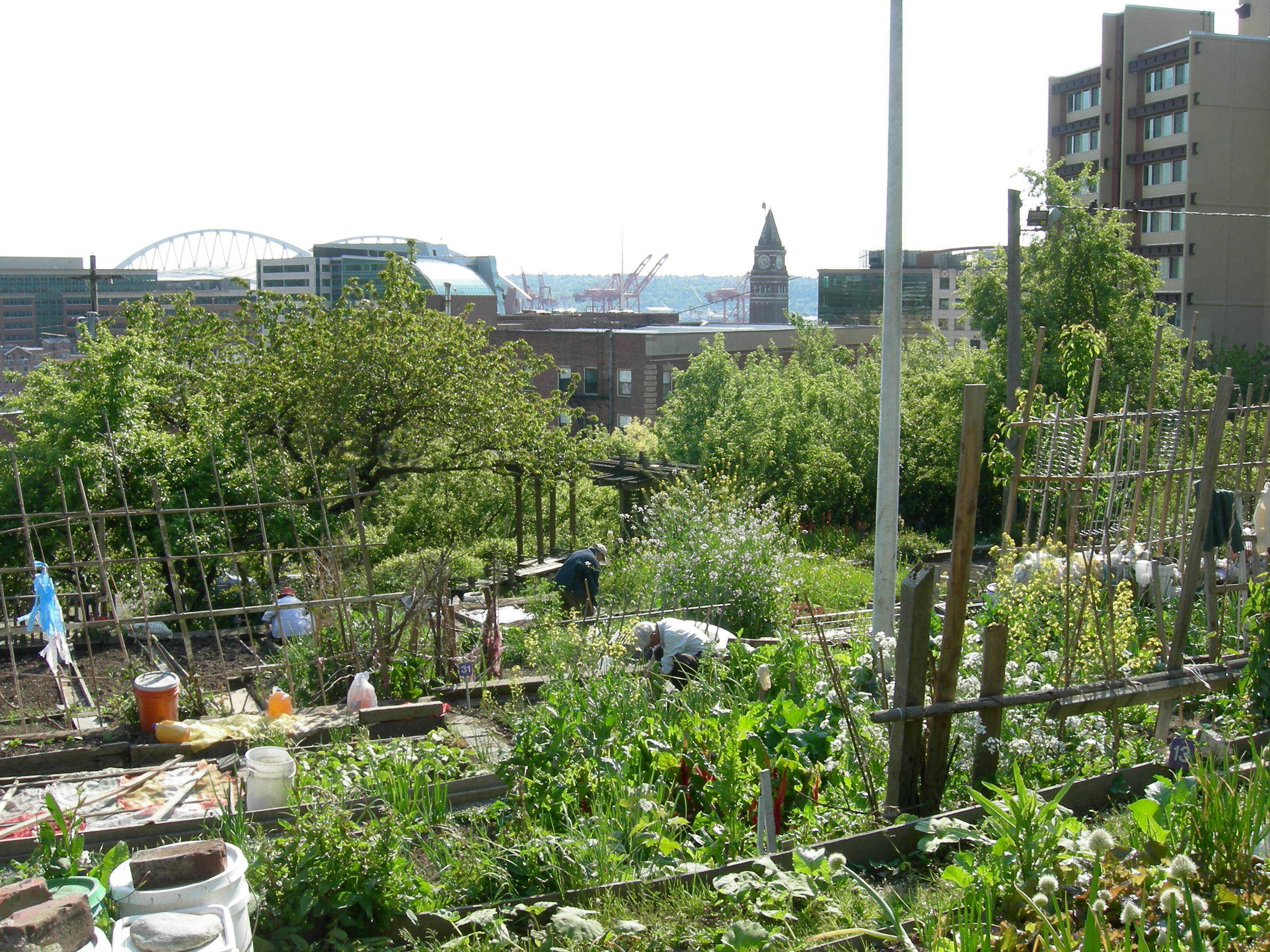
Community gardens provide many benefits to a surrounding area either in parks or vacant lots. This encourages people to create a green space for their community and beautify the area. The gardens also provide fresh fruits and vegetables to the community, and furthermore allow people to engage with the environment. These gardens can also be built on top of roofs and therefore benefit not just those tending to the garden, but to the area as a whole. It can provide habitat for pollinators, reduce the heat island effect in a city, and improve air quality. These gardens can also provide corridors for pollinators as they move to an area. Oftentimes these gardens can work in conjugation with community apiaries or they can build bee hotels to attract pollinators. This will ensure the prosperity of the garden along with the secure habitat for the pollinators. Schools are now using gardens to educate students on health and nutrition, agriculture, ecology, and science.
Rooftop Gardens
Chicago City Hall Roof Habitat, by Conservation Design Forum
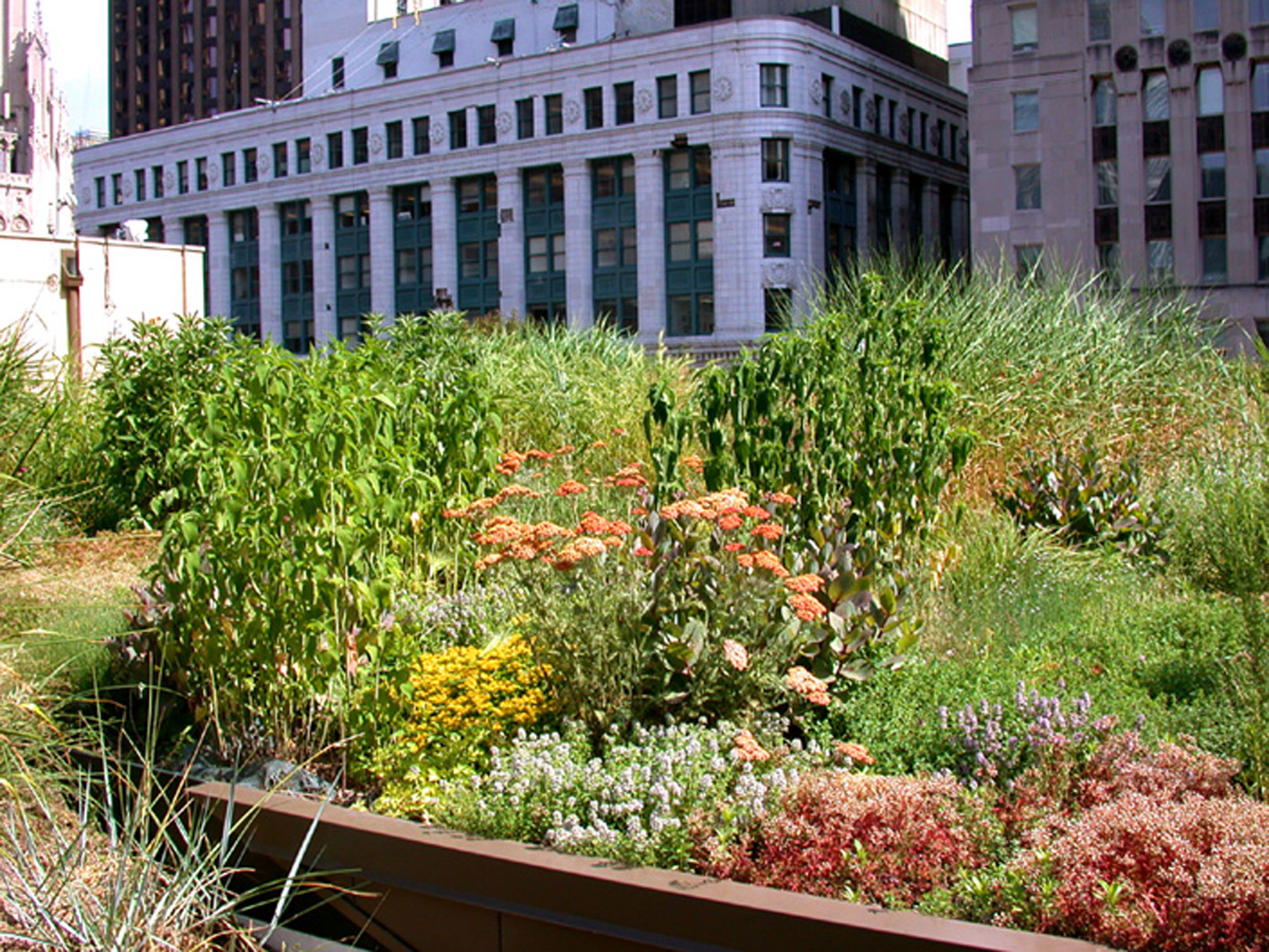
There are a few options that provide spaces for pollinators in urban settings. One example of these pollinator friendly urban spaces are rooftop gardens. They are primarily designed to reduce the urban heat island effect. This refers to when an area is significantly warmer than its surrounding region due to the concentration of asphalt roads, parking structures, and black tar covered roofs. These structures absorb the sun’s heat and warm the surrounding area up to 1 - 3°C. These rooftop gardens help with the heat island effect by protecting against direct sunlight and provide many other benefits as well. These roofs can improve air quality and provide habitat for local wildlife. They can be refuges for wildlife such as ground nesting birds by providing an undisturbed area. Oftentimes, these are a great opportunity to add beehives or bee hotels to the rooftop gardens to enhance pollinator habitats. It also provides a space for pollinators to forage or rest as they move about the city.
Resources
Bee Culture: Find a Local Bee Keeper
American Community Garden Association: Resources
National Gardening Association
Garden Design: Rooftop Garden Guide
About the Artist - Aaron Birk
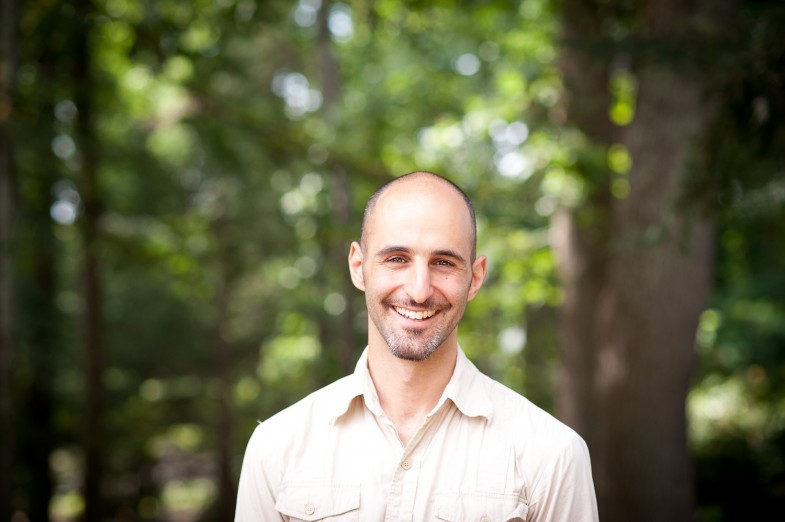
Aaron Birk is a graphic novelist that began working on Pollinator’s Corridor in 2003 at the same time while working as a forester in Central Park, New York. He has not only built a career in the visual arts but also in numerous other fields. He is a puppeteer, clothing designer, mushroom farmer, restoration ecologist, and teacher. Aaron received his Bachelor of Arts from Oberlin College. He went on to continue his education at The Pennsylvania Academy of Fine Arts and The Samuel S. Fleisher Art Memorial. If you would like to read or purchase his graphic novel please click on the following link to Amazon: The Pollinator's Corridor A Graphic Novel